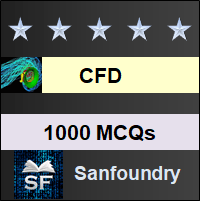
Computational Fluid Dynamics Multiple Choice Questions Highlights
- 1000+ Multiple Choice Questions & Answers (MCQs) in Computational Fluid Dynamics with a detailed explanation of every question.- These MCQs cover theoretical concepts, true-false(T/F) statements, fill-in-the-blanks and match the following style statements.
- These MCQs also cover numericals as well as diagram oriented MCQs.
- These MCQs are organized chapterwise and each Chapter is futher organized topicwise.
- Every MCQ set focuses on a specific topic of a given Chapter in Computational Fluid Dynamics Subject.
Who should Practice Computational Fluid Dynamics MCQs?
– Students who are preparing for college tests and exams such as mid-term tests and semester tests on Computational Fluid Dynamics.- Students who are preparing for Online/Offline Tests/Contests in Computational Fluid Dynamics.
– Students who wish to sharpen their knowledge of Computational Fluid Dynamics Subject.
- Anyone preparing for Aptitude test in Computational Fluid Dynamics.
- Anyone preparing for interviews (campus/off-campus interviews, walk-in interview and company interviews).
- Anyone preparing for entrance examinations and other competitive examinations.
- All - Experienced, Freshers and College / School Students.
Computational Fluid Dynamics Chapters
Here's the list of chapters on the "Computational Fluid Dynamics" subject covering 100+ topics. You can practice the MCQs chapter by chapter starting from the 1st chapter or you can jump to any chapter of your choice.- Philosophy of Computational Fluid Dynamics
- Some Simple CFD Techniques
- Governing Equations of Fluid Dynamics
- Boundary Conditions
- Mathematical Behaviour of Partial Differential Equations
- Basic Aspects of Discretization, Grid Generation with Appropriate Transformation
- Numerical Methods
- Finite Difference Methods
- Finite Volume Methods
- Turbulence Modelling
- High Resolution Schemes
- Diffusion Problem
- Convection-Diffusion Problems
- Incompressible Flows & Compressible Flows
- Transient Flows
- Discretization of the Source Term & Relaxation
1. Philosophy of Computational Fluid Dynamics
The section contains multiple choice questions and answers on cfd philosophy, research and design tool, computational fluid dynamics applications, cfd advantages and disadvantages.
|
|
|
2. Some Simple CFD Techniques
The section contains questions and answers on cfd softwares and implicit techniques direction.
|
|
|
3. Governing Equations of Fluid Dynamics
The section contains MCQs on reynolds transport theorem, state equations, flow models, eulerian and lagrangian conservation laws, velocity divergence, substantial derivative, continuity equations on finite control volume and infinitesimally small element, momentum equation, stress and strain tensor, energy equations on thermal properties, euler and Navier Stokes equation.
4. Boundary Conditions
The section contains multiple choice questions and answers on boundary conditions, boundary conditions on inlet, outlet, symmetry, constant pressure and periodic.
|
|
|
5. Mathematical Behaviour of Partial Differential Equations
The section contains questions and answers on partial differential equation, pde classification, well posed problems, behaviour of elliptic, parabolic and hyperbolic equations.
6. Basic Aspects of Discretization, Grid Generation with Appropriate Transformation
The section contains MCQs on discretization, thomas algorithm, discretization consistency, stability and convergence, conservativeness, boundedness, grid generation, errors and stability analysis.
|
|
|
7. Numerical Methods
The section contains multiple choice questions and answers on numerical methods components, mesh topology, discretization approaches, variable arrangements and velocity components, direct and iterative solvers for discretized equations, coupled and non linear equations solution.
8. Finite Difference Methods
The section contains questions and answers on finite difference methods and its errors, explicit and implicit finite difference methods, spectral methods, lax-wendroff and macCormack’s techniques.
|
|
|
9. Finite Volume Methods
The section contains MCQs on finite volume method, accuracy order, fvm arrangement, fvm structured and unstructured grids, fvm elements types and geometry.
|
|
|
10. Turbulence Modelling
The section contains multiple choice questions and answers on turbulence modelling, turbulent flows characteristics and structure, turbulent scale, kolmogorov energy spectrum, free and wall turbulence, turbulent viscosity, turbulent schmidt number, turbulent boundary layer, averaging rules and methods, large eddy simulation, reynolds averaged navier-stokes model, k-epsioln and k-omega model, spalart allmaras model, rng k epsilon, realizable k epsilon, shear stress transport model, y+ concept, turbulence model boundary conditions, filtering and sub grid models.
11. High Resolution Schemes
The section contains questions and answers on high resolution schemes, normalized variable formulation, convection boundedness criterion, tvd framework, high resolution schemes correction, downwind and normalized weighing factor.
|
|
|
12. Diffusion Problem
The section contains MCQs on 1-d steady state diffusion, multi dimensional steady state diffusion, discretization equation rules, orthogonal and non-orthogonal grids, green gauss and least square gradient for cartesian grids.
13. Convection-Diffusion Problems
The section contains multiple choice questions and answers on upwind and downwind schemes, central and hybrid difference schemes, second order upwind scheme, error sources, quick and fromm scheme.
|
|
|
14. Incompressible Flows & Compressible Flows
The section contains questions and answers on staggered grid, navier stokes equation special features, pressure calculations, rhie-chow interpolation, conservation equation, simple, simpler, simplec and piso algorithms.
15. Transient Flows
The section contains MCQs on two level methods, predictor corrector and multipoint methods, runge kutta method, transient simple and piso algorithms, crank nicolson and adams moulton schemes, non uniform time steps approaches, first and second order finite volume schemes.
16. Discretization of the Source Term & Relaxation
The section contains multiple choice questions and answers on source term discretization, under relaxation and residuals.
|
|
|
Wish you the best in your endeavor to learn and master Computational Fluid Dynamics!
